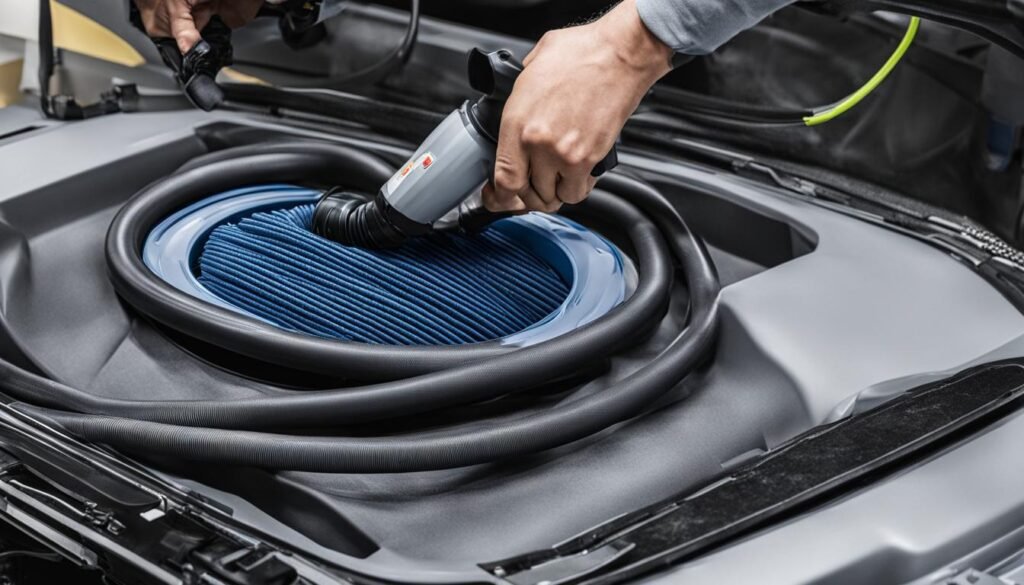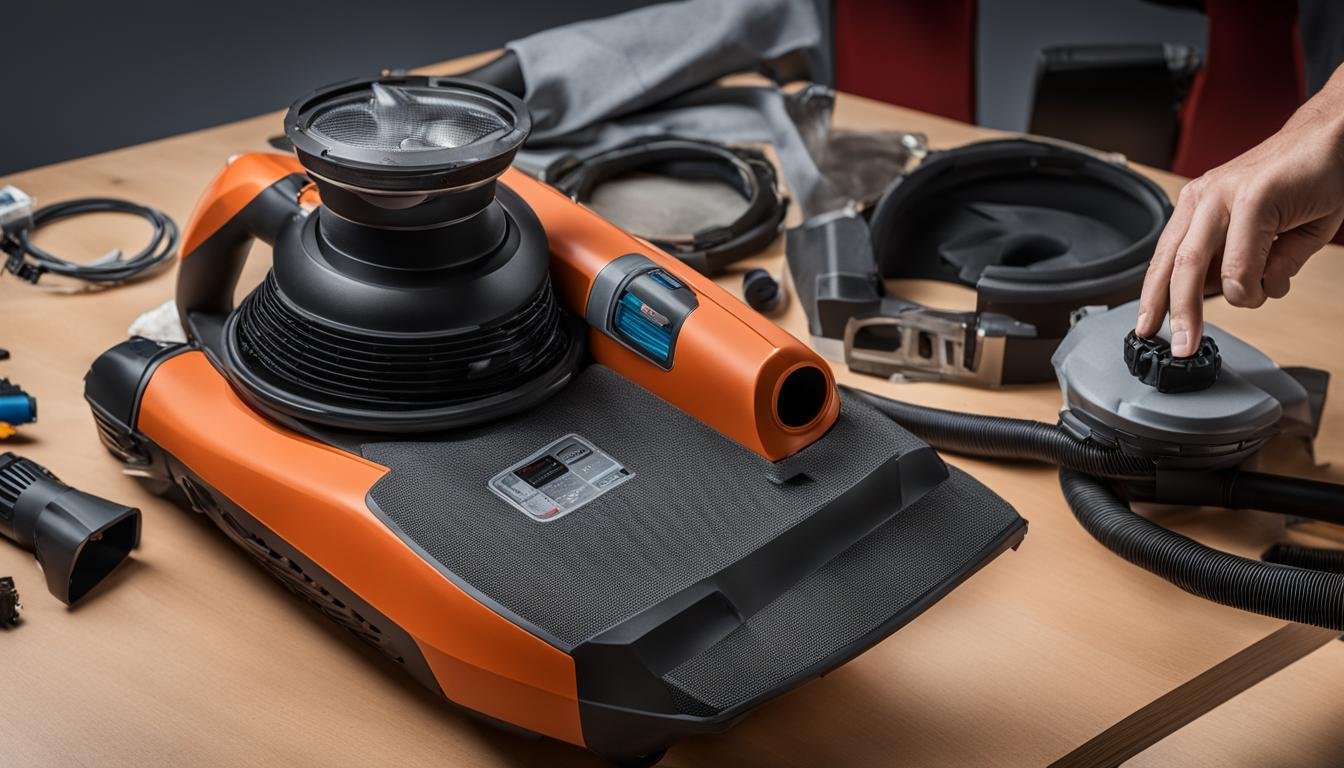As a Home Health Aide (HHA), I understand the importance of maintaining a clean and healthy environment for my patients. A key tool in achieving this is a well-maintained vacuum cleaner. Regular inspection and maintenance of the vacuum cleaner are crucial tasks that every HHA should prioritize.
When it comes to vacuum cleaner maintenance, there are two specific parts that I always make sure to check often. These parts play a vital role in the performance and efficiency of the appliance, ensuring that it continues to operate effectively. By paying attention to these areas, I can prevent potential issues and prolong the lifespan of the vacuum cleaner.
Key Takeaways:
- Regular inspection and maintenance of a vacuum cleaner are essential for HHAs.
- Checking two specific parts can help prevent issues and extend the lifespan of the appliance.
- A properly maintained vacuum cleaner contributes to a clean and safe environment for patients.
- By taking care of the vacuum cleaner, HHAs ensure optimal performance in patients’ homes.
- Proactive maintenance reduces the need for costly repairs or replacements.
Vacuum Cleaner Care Tips for HHAs
As an HHA, taking care of your patients’ homes involves maintaining the appliances, including the vacuum cleaner. In addition to checking the specific parts mentioned earlier, there are several other care tips and maintenance tasks that you should be aware of when it comes to vacuum cleaners. By following these guidelines, you can ensure the longevity and performance of the appliance, helping you clean efficiently and effectively.
1. Clean the Brushroll Regularly
The brushroll is a crucial component of the vacuum cleaner that helps to agitate carpet fibers and pick up dirt and debris. Over time, hair, threads, and other materials can get tangled around the brushroll, compromising its performance. It is important to regularly remove any debris and clean the brushroll to prevent clogs and maintain optimal suction power.
2. Check and Replace Filters
Vacuum cleaner filters play a vital role in trapping dust, allergens, and other particles. Over time, these filters can become clogged, decreasing the appliance’s efficiency. Check the filters regularly and clean or replace them as recommended by the manufacturer. This simple step can greatly improve the air quality in your patients’ homes.
3. Empty the Dustbin or Bag
An overflowing dustbin or bag can hinder the vacuum cleaner’s performance and reduce suction power. Make it a habit to empty the dustbin or replace the bag when it reaches the recommended capacity. This will prevent debris from spilling back onto the cleaned areas and ensure efficient cleaning every time.
4. Address Vacuum Cleaner Troubleshooting
If you encounter any issues with your vacuum cleaner, it’s important to troubleshoot them promptly. Common problems include loss of suction, unusual noises, and malfunctioning accessories. Consult the manufacturer’s manual for troubleshooting tips or seek professional assistance to resolve the issue and prevent further damage to the appliance.
“Regularly maintaining and caring for your vacuum cleaner not only improves its performance but also extends its lifespan, saving you time and money in the long run.”
Incorporating these vacuum cleaner care tips into your routine will ensure that you’re able to provide a clean and healthy environment for your patients. By taking the time to properly maintain and troubleshoot the appliance, you can tackle the challenges of cleaning with ease and efficiency.
| Care Tip | Description |
|---|---|
| Clean the Brushroll Regularly | Remove debris from the brushroll to prevent clogs and maintain suction power. |
| Check and Replace Filters | Clean or replace filters as recommended to improve air quality and efficiency. |
| Empty the Dustbin or Bag | Empty the dustbin or replace the bag to prevent loss of suction and debris spillage. |
| Address Vacuum Cleaner Troubleshooting | Resolve issues promptly to prevent further damage and maintain optimal performance. |
Remember, a well-maintained vacuum cleaner is an essential tool in your caregiving arsenal, ensuring that you can keep your patients’ homes clean and comfortable.

Conclusion
Regular maintenance and inspection are crucial for ensuring the proper cleaning and optimal performance of a vacuum cleaner in patients’ homes. As a Home Health Aide (HHA), it is essential to prioritize the care and maintenance of this important cleaning tool. By routinely checking and caring for the vacuum cleaner’s filters, brushroll, and following other maintenance guidelines, HHAs can contribute to a clean and safe environment for their patients.
One of the key aspects of vacuum cleaner maintenance is ensuring the brushroll is properly maintained. This accessory is responsible for agitating and picking up dirt and debris from carpets and floors. Regularly removing the brushroll and cleaning it can prevent clogs, improve suction, and extend the lifespan of the vacuum cleaner. It is important to refer to the manufacturer’s instructions for guidance on brushroll maintenance and replacement if necessary.
Additionally, utilizing the right vacuum cleaner accessories can greatly enhance the cleaning efficiency and effectiveness. From specialized attachments for upholstery to crevice tools for tight spaces, having a range of accessories allows for thorough cleaning in different areas of the home. By utilizing the appropriate accessories, HHAs can ensure that no area is left untouched and provide a higher level of cleanliness for their patients.
In conclusion, regular maintenance, including brushroll maintenance and utilizing the right accessories, is essential for optimal vacuum cleaner performance as an HHA. By taking care of this important cleaning tool, HHAs can contribute to a clean and safe environment for their patients, ensuring the best possible caregiving experience.
FAQ
What two parts of a vacuum cleaner should an HHA check often?
As an HHA, it is important to regularly check the filters and brushroll of a vacuum cleaner. These two parts play a crucial role in the vacuum cleaner’s cleaning performance and should be inspected frequently to ensure optimal functionality.
What are some vacuum cleaner care tips for HHAs?
HHAs should follow these care tips to maintain their vacuum cleaners:
– Empty the dustbin or bag regularly to prevent clogs and to maintain suction power.
– Clean or replace the filters as recommended by the manufacturer to prevent allergens and dust from being released into the air.
– Check the brushroll for any tangled hair, fibers, or debris and clean it if necessary. Replace the brushroll if it is worn out or damaged.
– Keep the vacuum cleaner’s attachments and accessories clean and organized for easy access and efficient cleaning.
– Store the vacuum cleaner in a dry and safe place to protect it from damage.
– Follow the manufacturer’s instructions for any specific maintenance tasks or troubleshooting guidelines.
Are there any other vacuum cleaner accessories or maintenance tips to consider?
Yes, in addition to the regular care tips mentioned earlier, HHAs should also pay attention to the following:
– Check and clean the vacuum cleaner’s hose and attachments for any obstructions or damage.
– Inspect and clean the vacuum cleaner’s wheels or rollers to ensure smooth movement and prevent scratching or damaging floors.
– Consider using specialized attachments for specific cleaning tasks, such as a crevice tool for tight spaces or an upholstery brush for cleaning furniture.
– If the vacuum cleaner has a removable and washable filter, make sure to clean it regularly and allow it to dry completely before reinserting it.
– If you encounter any problems with the vacuum cleaner’s performance or functionality, consult the user manual or contact the manufacturer for troubleshooting assistance.
Source Links
- https://milnepublishing.geneseo.edu/home-health-aide/chapter/care-of-the-home-and-personal-belongings/
- https://courses.lumenlearning.com/suny-home-health-aide/chapter/what-is-home-health-care/
- https://med.libretexts.org/Bookshelves/Allied_Health/Foundations_for_Assisting_in_Home_Care_(McLain_O’Hara-Leslie_and_Wade)/10:_Care_of_the_Home_and_Personal_Belongings/10.03:_Unit_C-_Ways_to_Be_Safe_and_Save_Energy_and_Time/10.3.02:_Time_Management





Leave a Reply